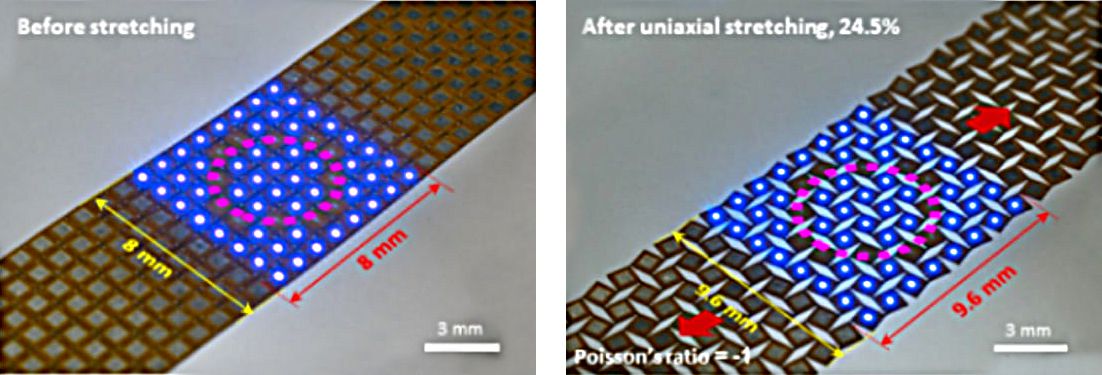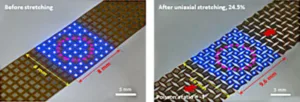A research team led by Jang Bong-kyun of the Department of Nano-Mechanics at the Korea Institute of Machinery and Materials (Daejeon, South Korea) or KIMM is developing a technology to produce displays that, when uniaxially stretched up to 25 percent, continue to present an image free of distortion.

The design and manufacturing technology used in these displays is based on the use of meta-materials. Meta-materials are materials that have a property that does not occur naturally in nature. A display based on the use of meta-materials is called a meta-display.
In stretchable electronics, components are typically arranged in arrays on an elastomeric substrate. The width of most naturally occurring elastomeric substrate materials will decrease when the material is stretched along a direction perpendicular to the width. It follows that an array of components mounted on such a substrate will deform when the substrate is stretched. More specifically, if a conventional elastomeric material is used as a substrate in a stretchable display and the display includes an array of microLEDs mounted on the substrate, the image produced by the micro-LED array will distort if the substrate is stretched.
The research undertaken by the KIMM research team was aimed at creating a display in which the image does not distort when the substrate is uniaxially stretched. The approach used by the team was based on a specific type of meta-material called an auxetic meta-material. An auxetic meta-material is defined as a material that has a negative Poisson’s ratio. Poisson’s ratio relates to the change in the width of a material when the material is stretched in the lengthwise direction. Since auxetic meta-materials have a negative Poisson’s ratio, they expand in a direction perpendicular to the stretch direction. More specifically, when a material with a Poisson’s ratio of -1 is stretched by some factor in a lengthwise direction, it stretches by the same factor in the perpendicular, widthwise direction. It follows that, if a display is fabricated on such a substrate material, it becomes possible, at least in principle, to produce an image that does not distort when the substrate/display is stretched.
A recent article on this topic by the team is entitled “Auxetic Meta-display: stretchable display without distortion.” It was published in the journal Advanced Functional Materials on February 15th, 2022. A copy of the article can be found here. Paraphrasing this article, here are some top level details on the approach investigated by the team.
First, a few background comments. Auxetic meta-materials exhibit dilatational deformation under uniaxial stretching and have a negative Poisson’s ratio, which can be tuned by designing the unit cell structures. Among various possible auxetic meta-structures, those with rotational squares and hinges can have a Poisson’s ratio of -1. In fabricating two dimensional auxetic meta-materials, kirigami technology is helpful in the implementation of stretchability. By partially cutting sheets or planar devices, the deformation at exterior edges influences the disturbances in the interior kirigami structures. This behavior makes the structure compliant and imparts stretchability, even if it is composed of stiff materials with poor stretchability.
Next, comments specific to displays. Micro-LEDs are transferred onto a so-called auxetic meta-circuit board that includes a kirigami meta-pattern designed using finite element analysis. The meta-display is fabricated on a polyimide film, a material used widely in the display industry. By combining the concepts of kirigami-based auxetic meta-materials with micro-LED displays, a meta-display featuring a stretchability of up to 24.5% without image distortion was demonstrated.
A video illustrating the stretching of a prototype meta-display developed by the team is appended to the end of this article. A picture of the meta-display before and after stretching is presented in the figure below.
 Comparison image before and after stretching the meta-display.
Comparison image before and after stretching the meta-display.
A second type of prototype was produced by the team to further demonstrate the capabilities of the new technology. In this case, a 3 inch stretchable meta-display was attached to a hemispherical surface with a radius of 80 cm. While a conventional stretchable display so mounted would show wrinkles and creases, the meta-display attached smoothly and without any damage.
The technical article written by the team includes a discussion of a scalable manufacturing method for meta-displays that incorporates the roll transfer of micro-LEDs with the kirigami meta-circuit board. The process is described as a highly efficient and enabling of large area continuous transfer of nano-materials. Expanding on this last comment, the team represents that the new kirigami-based technology offers several advantages including readiness, compatibility with conventional display fabrication processes, the ability to be scaled up and a process that uses common materials.
In order to respond to the growing commercialization of micro (and mini) LED technologies, the team has established two spin-off companies to promote the practical use of their new technology. These companies are YTS Micro-Tech Co., Ltd. (Daejeon, South Korea) and MCK-Tech Co., Ltd. (Daejeon, South Korea). -Arthur Berman
The Korea Institute of Machinery and Materials, Bongkyun Jang, +82-42-868-7850, [email protected]

